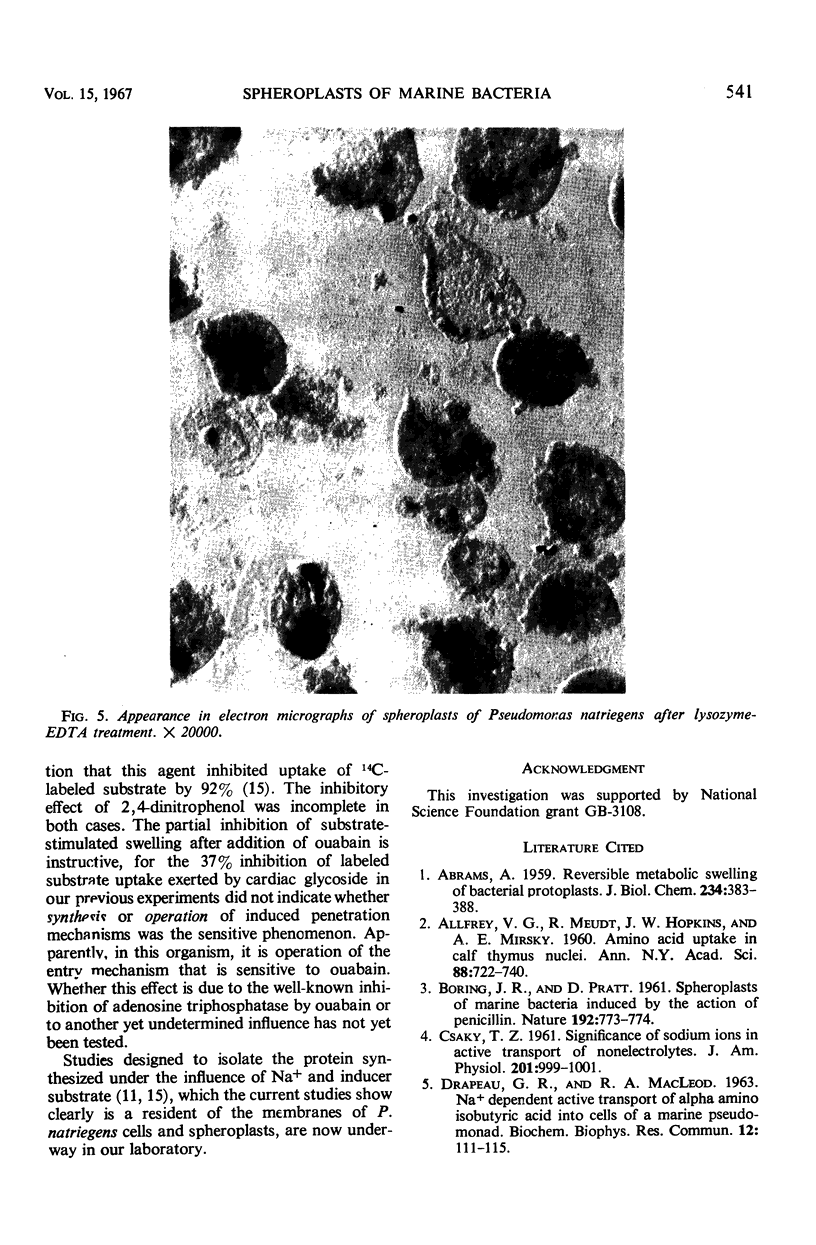Abstract
Penetration of substrates into marine bacteria as influenced by cations has been demonstrated by the effects of increased osmotic pressure in spheroplasts of these cells. Spheroplasts of Pseudomonas natriegens, stabilized with lactose, underwent a metabolic swelling in the presence of a substrate to which they had been induced. Maximal and persistent swelling was achieved only by addition of catabolizable substrate and both Na+ and K+. Addition, along with substrate, of Na+ alone or K+ alone did not stimulate swelling; no metabolic swelling occurred in the presence of a sugar to which the cells had not been induced. Confirmation of rapid uptake by induced cells of the inducer sugar, l-arabinose, but not the d-isomer, was obtained with 14C-labeled substrate. Addition of NaN3 completely inhibited swelling, and 2, 4-dinitrophenol and ouabain each suppressed it by 50%, indicating requirement for energy metabolism and involvement of an adenosine triphosphatase in the penetration phenomena of these cells.
Full text
PDF





Images in this article
Selected References
These references are in PubMed. This may not be the complete list of references from this article.
- ABRAMS A. Reversible metabolic swelling of bacterial protoplasts. J Biol Chem. 1959 Feb;234(2):383–388. [PubMed] [Google Scholar]
- ALLFREY V. G., HOPKINS J. W., FRENSTER J. H., MIRSKY A. E. Reactions governing incorporation of amino acids into the proteins of the isolated cell nucleus. Ann N Y Acad Sci. 1960 Aug 31;88:722–740. doi: 10.1111/j.1749-6632.1960.tb20066.x. [DOI] [PubMed] [Google Scholar]
- CSAKY T. Z. Significance of sodium ions in active intestinal transport of nonelectrolytes. Am J Physiol. 1961 Dec;201:999–1001. doi: 10.1152/ajplegacy.1961.201.6.999. [DOI] [PubMed] [Google Scholar]
- Drapeau G. R., MacLeod R. A. A role for inorganic ions in the maintenance of intracellular solute concentrations in a marine pseudomonad. Nature. 1965 May 1;206(983):531–531. doi: 10.1038/206531a0. [DOI] [PubMed] [Google Scholar]
- MACLEOD R. A., ONOFREY E. Nutrition and metabolism of marine bacteria. II. Observations on the relation of sea water to the growth of marine bacteria. J Bacteriol. 1956 Jun;71(6):661–667. doi: 10.1128/jb.71.6.661-667.1956. [DOI] [PMC free article] [PubMed] [Google Scholar]
- MACLEOD R. A., ONOFREY E. Nutrition and metabolism of marine bacteria. III. The relation of sodium and potassium to growth. J Cell Physiol. 1957 Dec;50(3):389–401. doi: 10.1002/jcp.1030500305. [DOI] [PubMed] [Google Scholar]
- PAYNE W. J. Effects of sodium and potassium ions on growth and substrate penetration of a marine pseudomonad. J Bacteriol. 1960 Nov;80:696–700. doi: 10.1128/jb.80.5.696-700.1960. [DOI] [PMC free article] [PubMed] [Google Scholar]
- PAYNE W. J. Studies on bacterial utilization of uronic acids. III. Induction of oxidative enzymes in a marine isolate. J Bacteriol. 1958 Sep;76(3):301–307. doi: 10.1128/jb.76.3.301-307.1958. [DOI] [PMC free article] [PubMed] [Google Scholar]
- REPASKE R. Lysis of gram-negative bacteria by lysozyme. Biochim Biophys Acta. 1956 Oct;22(1):189–191. doi: 10.1016/0006-3002(56)90240-2. [DOI] [PubMed] [Google Scholar]
- REPASKE R. Lysis of gram-negative organisms and the role of versene. Biochim Biophys Acta. 1958 Nov;30(2):225–232. doi: 10.1016/0006-3002(58)90044-1. [DOI] [PubMed] [Google Scholar]
- RHODES M. E., PAYNE W. J. Further observations on effects of cations on enzyme induction in marine bacteria. Antonie Van Leeuwenhoek. 1962;28:302–314. doi: 10.1007/BF02538743. [DOI] [PubMed] [Google Scholar]
- RIKLIS E., QUASTEL J. H. Effects of cations on sugar absorption by isolated surviving guinea pig intestine. Can J Biochem Physiol. 1958 Mar;36(3):347–362. [PubMed] [Google Scholar]
- ROBINSON J., GIBBONS N. E., THATCHER F. S. A mechanism of halophilism in Micrococcus halodenitrificans. J Bacteriol. 1952 Jul;64(1):69–77. doi: 10.1128/jb.64.1.69-77.1952. [DOI] [PMC free article] [PubMed] [Google Scholar]
- Rhodes M. E., Payne W. J. Influence of Na+ on synthesis of a substrate entry mechanism in a marine bacterium. Proc Soc Exp Biol Med. 1967 Mar;124(3):953–955. doi: 10.3181/00379727-124-31894. [DOI] [PubMed] [Google Scholar]
- SCHWEIGHOFER D., STARLINGER P. Zur Protoplastierung von E. coli B mit Lysozym und Versen. Arch Mikrobiol. 1959;32(3):219–223. [PubMed] [Google Scholar]
- SISTROM W. R. On the physical state of the intracellularly accumulates substrates of beta-galactoside-permease in Escherichia coli. Biochim Biophys Acta. 1958 Sep;29(3):579–587. doi: 10.1016/0006-3002(58)90015-5. [DOI] [PubMed] [Google Scholar]
- Zinder N. D., Arndt W. F. PRODUCTION OF PROTOPLASTS OF ESCHERICHIA COLI BY LYSOZYME TREATMENT. Proc Natl Acad Sci U S A. 1956 Sep;42(9):586–590. doi: 10.1073/pnas.42.9.586. [DOI] [PMC free article] [PubMed] [Google Scholar]



